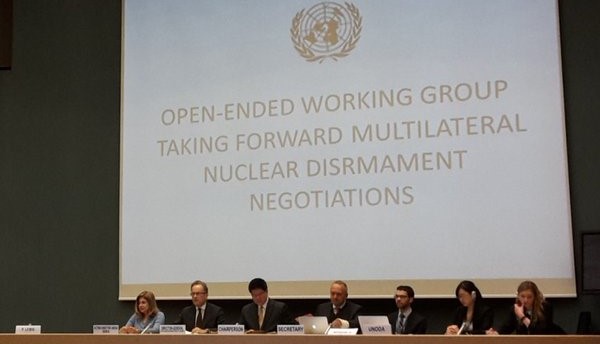Governments and NGOs met in Geneva this week for the first three days of the May sessions of the Open Ended Working Group on Taking Forward Multilateral Nuclear Disarmament Negotiations (OEWG). For two weeks, they are discussing the why, what and how to achieve a nuclear-weapon-free world:
- Why – risks and humanitarian consequences of nuclear weapons use
- What – elements that would comprise legal measures (agreements, treaties…)
- How – negotiating approaches, timing and sequences of legal measures to be adopted
The key topics for the first week (May 2-4) were on nuclear risk reduction, transparency and building awareness of the humanitarian impact of nuclear weapons. (See OEWG program and schedule)
On nuclear risk reduction and transparency, there appeared to be general support for a range of measures including de-alerting, rescinding launch-on-warning policies, developing verification capacities and cooperation, securing nuclear materials and facilities including nuclear command and control systems, strengthening assurances on the non-use of nuclear weapons, reducing or eliminating tactical nuclear weapons, and further reducing the role of nuclear weapons in security doctrines.
The main issue regarding these measures is how to convince the nuclear-armed States to adopt them.
Humanitarian initiative – talking past each other
On the other hand, there continue to be big divisions between key groupings of governments on the implications of the ‘humanitarian initiative’, i.e. the recent attention that has been given to the catastrophic impact of a potential use of nuclear weapons.
Where-as most of the non-nuclear States argue that the evidence of such catastrophic consequences constitutes a clear imperative for the prohibition and elimination of nuclear weapons, nuclear-reliant States (including NATO states, Japan, South Korea and Australia) continue to argue that nuclear deterrence plays a role in their security, including to prevent the use of nuclear weapons by a potential adversary. See Security and nuclear deterrence – talking past each other.

Approaches to nuclear disarmament
Delegations also commented on the main approaches to nuclear disarmament negotiations outlined in the OEWG Chair’s OEWG Chair’s Synthesis Paper. The paper provides a summary of the ideas discussed in the February session of the OEWG.
The approaches identified by OEWG Chairperson Ambassador Thani Thongphakdi are ‘a comprehensive nuclear weapons convention, a nuclear weapon ban treaty, a framework agreement and a progressive approach based upon building blocks.’
Ambassador Thongphakdi has noted that the elements (the what) of these approaches are fundamentally the same – what differs is the sequencing and participation (the how).
Sequencing refers to which key elements come first – those related more to prohibition (of use, threat of use and possession) or those related more to control and reductions of the weapons systems (fissile material treaty, test ban, stockpile reductions, verification measures…).
Participation refers to whether the measures would be negotiated and adopted (initially) by nuclear-armed States, non-nuclear States or all States.

Next week the OEWG will discuss these approaches in more detail. In the meantime there were a number of working papers submitted by delegations on the different approaches, including:
- Addressing nuclear disarmament Recommendations from the perspective of nuclear weapon free zones, Submitted by Argentina, Brazil, Costa Rica, Ecuador, Guatemala, Indonesia, Malaysia, Mexico and Zambia
- The road to zero: the progressive approach, Submitted by Belgium, Canada, Germany, Latvia and Netherlands
- A legal instrument for the prohibition and elimination of nuclear weapons, International Association of Lawyers Against Nuclear Arms
- Quest of Legal Measures with Specificity and Feasibility for Nuclear Disarmament, Peace Depot Inc.
- Building the framework for a nuclear-weapon-free world, Basel Peace Office
- Options for a framework agreement, Middle Powers Initiative
- A treaty banning nuclear weapons, Article 36 and the Women’s International League for Peace and Freedom
- Accelerating global nuclear disarmament a menu of 16 policy options, Netherlands Institute of International Relations “Clingendael”
The OEWG will also discuss next week the elements for legal measures to achieve a nuclear-weapon-free world and the role of nuclear weapons in security doctrines in the 21st Century. See OEWG schedule and program.M2k Tekno

